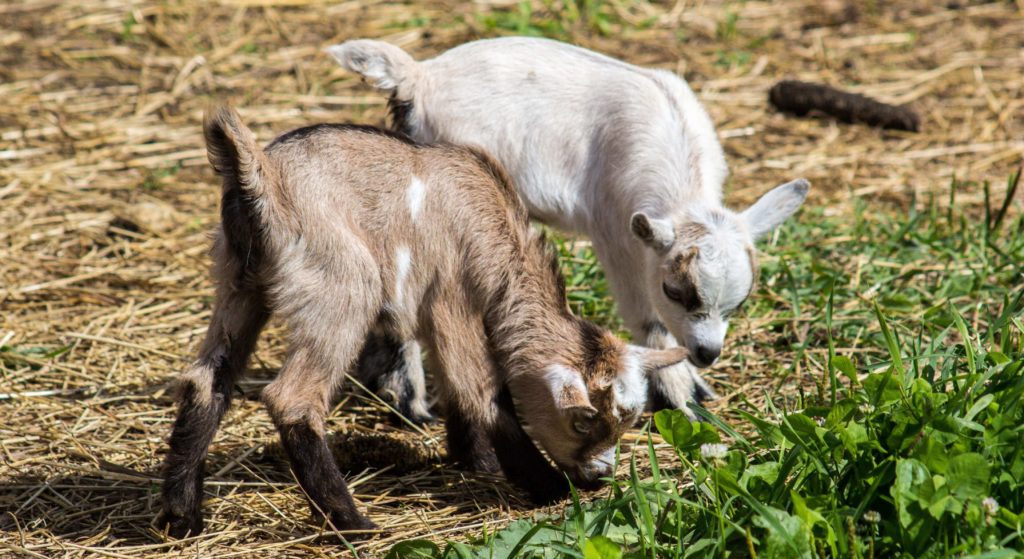
Goats are entertaining, adventurous, and curious animals. They have personality and spunk. Goats are popular for both milk and meat. Their milk often has a higher fat content than cows so they are popular for soaps and cheeses. They are also used for weed control and loved as pets.
If you are considering raising goats, there are a few things you will need to know about how to raise goats.
1. Understand Some Goat Facts
There are some things about goats you should know.
Goats need companionship. They have a very strong herd instinct. You should plan on having at least two goats. If you only have a single goat, it will be more depressed and not as happy.
Goats are becoming increasingly popular as a farm animal or a backyard pet. They are being raised for laughter and entertainment, meat, milk, their fur, and as bush goats. Nanny goats are generally mellow, but billy goats can be very ornery.
Know goat terminology. A male uncastrated goat is a billy or a buck. A female goat is a nanny or a doe. A castrated goat is called a wether. Baby goats are called kids. Goats in a rut is a period where billy goats get very hormonal and ready to breed. They get super smelly during this time.
You will also want to seriously consider if you want billy goats as well as does. Billy goats are a lot stinkier, ornery, and horny. They can be a lot more difficult to control than nanny goats or wethers.
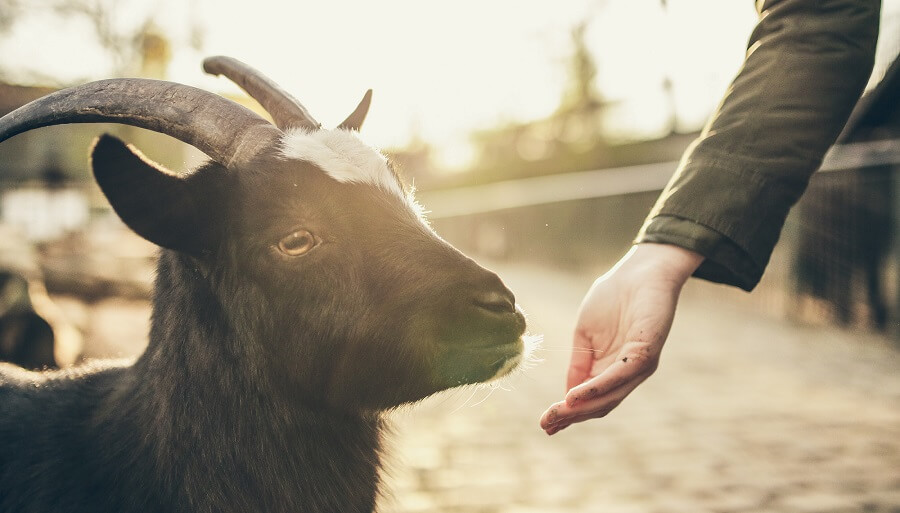
2. Set Up Fencing For Your Goats
Goats have a reputation for getting out. They are smart and will look for and remember the weakness in a fence. Goats are very persistent. They will constantly look for a way to escape. That means that even a single lapse in latching the gate or a broken post will mean an adventure for your goat!
Goats love to feel things with their lips and tongues. They can open latches simply by feeling a latch with their mouths.
You will need to have a goat-proof fence to keep your goats contained. Good fencing needs to be strong, durable, and high. Goats will lean, push, climb, and jump over fences. They will try to stick their heads through holes and gaps. It’s important to have small enough gaps that goats won’t get stuck trying to push through.
Regardless of the type of fencing, you decide on, you will need to maintain it. Fences will wear and shift, especially with persistent goats. Keeping your fences maintained and quickly repairing any gaps is essential to keeping goats fenced in.
Gaps in the fencing need to be small enough to keep goats from pushing their heads through. This will create a major predator problem because your goat won’t be able to run away or defend themselves. They can also get injured while stuck.
Lastly, goat fencing should also be designed to protect goats from predators.
- Goat fencing should be durable, strong, and resist climbing
- It needs to be maintained and repaired consistently
- It should keep predators out
- It should not have gaps that allow goats to get stuck.
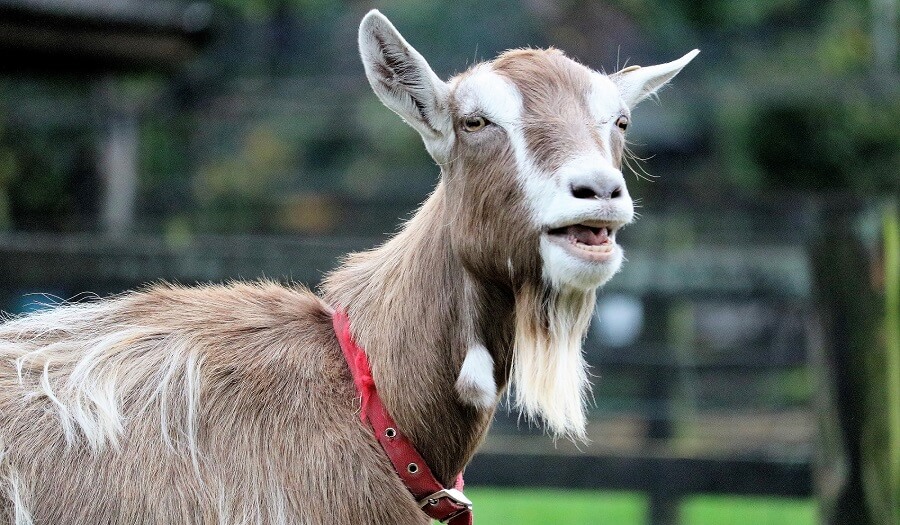
There are several types of fencing options that keep fences in:
Electrical Fencing and T-Posts: Electrical fencing is one of the cheapest and most effective ways to keep goats contained. T-posts are easy to install. Simply run 5-6 electrical wires along the posts. Put the first strand 6 inches high, the second at 1 foot. The third, fourth and fifth strand should be run at 2 feet, 3 feet, and 4 feet high.
Electrical fencing does require more maintenance in the summer. Weeds, grass, and bushes need to be kept trimmed. Plants that touch or lean against the fence will ground it out and make it unreliable.
Because goats continually test the fence, they quickly find out that the fence is not shocking anymore and will escape through it.
- Low cost and easy to put up
- Weeds and bushes must be kept trimmed
- Bucks may still get through
Livestock Fencing of 4’ x 4’ Squares: Strongly welded livestock fencing is another good option to contain goats. The welded fence is heavy duty and will hold up under climbing, pushing and pulling on the fence. The squares are small enough that goats won’t be able to push their heads through and get stuck. (Kids can get through but won’t get stuck.)
Goat fencing is more expensive. It would be costly to fence in acres of land. It is 4 feet tall and some goat breeds can jump over it.
- Strong fencing withstands climbing and pushing
- More expensive
- Must be installed tight to be effective
Cheap Welded Fencing: Cheaper welded fencing, garden fencing, and other lower-cost fencing will not keep goats in. It will be more costly in the long because your goats will push until the welding breaks, bends or stretches. It will cost you endless time trying to repair.
It will bend and allow goats to climb over the fence.
Wood Fences: Wood fences can be effective at keeping goats out. However, they should be strong and the wood checked and repaired at least monthly.
Rails should be sturdy and secured against the posts. The fence should be at least four feet high or goats will jump over it. Some breeds will jump over even a 4-foot fence. Those breeds include Nigerian Dwarf, Saanen or other larger breeds.
Wood fences are generally more expensive to put up and to maintain. But they are often more aesthetically pleasing for many people.

3. Prepare Goat Housing
Goats need some sort of housing. Usually, 3 sides and a roof are enough to keep your goats warm and safe from the elements. Cold, wet climates may need four-sided huts with a door for goats to enter.
Adult goats will generally grow a winter hair that keeps them warm in colder climates, But, there are some breeds that don’t do as well in the cold.
- Alpine Toggenburg, Saanen, and Oberhaslis do very well in colder climates
- Nubian and Lamancha are tropical goats and need better shelter in cold climates
The most vital part of the housing is that the goats have a place that is drat free and dry. Goats will get sick and ailments from damp, moist, or moldy areas. They usually don’t have as many respiratory issues as sheep, but still, need clean dry air. Mold and mildew will cause issues in a goat and it can cause death within 24 hours.
Goat houses don’t need to be expensive or complicated. You can usually use a modified existing structure. If you haven’t raised goats before, then consider putting up a temporary shelter until you’ve grown your herd and are sure that you want to keep goats around.
Does who are kidding (having babies) will need to have warm shelter. Kids need a warm, dry shelter because they are especially susceptible to the weather. This is especially important. Their shelter needs to have good ventilation and to be draft-free.
Without good shelter, the mortality rate on your kids will be higher.

4. Provide Bedding
Goats need dry bedding to nest down into. Since goats will waste a portion of their hay by tossing, walking through it or throwing it around, simply throw the wasted hay into their bedding.
Use old, wet and grungy bedding for compost in your garden.
Goat bedding can be made of straw, hay, wood chips, or sawdust. Stray and wood chips are usually cheaper options. Many utility companies will drop off wood chips in the spring when they cut trees that are interfering with phone and electrical wires.
Make sure that bedding is cleaned and kept dry. If you are using sawdust, make sure that the bedding area is free of wind or the sawdust can blow into the air and cause respiratory issues. Areas with frequent wind aren’t usually suited for sawdust as bedding.
5. Goats Need Food With Specific Nutrients
Despite their reputation, goats really cannot stomach metal, trash, and other human products. Goats need good hay. They need greens, leaves, and other natural foods. The best hay for goats is alfalfa. A Timothy/grass mix or clover are also good options. Other dry hay of horse quality will also work.
Goats need about 2-4 pounds of hay. They can usually get much of this requirement by foraging but will need to be offered additional food to supplement their diet. Goats will forage on grass if needed but prefer to forage on other greens such as weeds, leaves, and bushes.
Hay pellets can also be offered. Pregnant does need a grain feed or pellets to supplement their nutritional needs.
If you change your goats’ feed, make sure that you do it gradually. Goats use bacteria in their stomachs to process their food. Making drastic changes can alter it and cause sickness with your goats. Instead, gradually add in the new feed in with the old. Increase the percentage of the new feed.
Grazing goats should not be only offered a diet of grass. Goats need more nutrients. Additionally, they should have enough space that they don’t wear out the land. If goats are kept in a smaller area, they should be rotated to other pastures to keep the land clean and the goats healthy.

6. Goats Need Specific Minerals
Goats also need certain minerals and vitamins to stay healthy. They need copper and specific goat feed is supplemented with copper. Sheep feed is not. Mineral supplements can be offered in loose form or a mineral block, which allows goats to lick the minerals.
Loose form is usually available specially formatted for goats and their needs. Mineral blocks are usually made with cattle in mind and don’t always have the right combination for goats.
Minerals should be offered at-will, meaning that goats can access them anytime they need.
They prefer and need salt in their diet. If your mineral supplement doesn’t include salt, you will need to include salt as an available mineral. Offering baking soda will also help in their digestion.
Goats need the following minerals to stay healthy:
- Copper
- Salt
- Zinc
- Calcium and Phosphorus
- Iodine
- Sodium bicarbonate (baking soda)
- Manganese
- Potassium
- Sulfur
- Iron
- Vitamins A, D, and E
Side Effects of Mineral Deficiencies In Goats:
Goats will show symptoms of mineral deficiencies. These symptoms include weak muscles (selenium or iron) and trouble breathing (selenium). It includes stiff joints, skin issues, disinterest inbreeding, excessive saliva or deformed hooves (zinc).
Stillbirths, abortion, coarse hair, weight loss, and low milk supply are often caused by a copper deficiency. Other symptoms include goiters (iodine), licking the ground (sodium), and stillbirths, slow growth rate, and reduced fertility (manganese).
For a list of recommended goat minerals check out this page.

7. Provide Clean, Fresh Water
Goats need fresh, clean water. Provide a fresh supply of water daily. During dusty or windy times, your goats many need their water changed multiple times a day. Dirty water can make goats ill.
You can use a pond or a creek to water your goats, but make sure that the water has been tested and doesn’t contain harmful bacteria. Stagnant water can easily make goats ill.
8. Deworm Goats
Goats have worms. It is unavoidable. But, keeping the worms under control is vital to keeping your goats healthy. This can be done through a dewormer. Dewormers come in organic herbal remedies or medical remedies.
Organic remedies are effective but need to be applied consistently to work the best. Medical remedies can be quick and effective, but often more expensive.
You can get your goat’s poop tested for worms to identify if you have a worm issue or not. There are many symptoms of a high worm population in goats.
These symptoms include sudden weight loss, pale eyelids and gums, rough coat, and a sick looking goat. Goats can have different types of worms and your local vet can help to identify the types of worms and the best treatment for them.
9. Trim And Brush Your Goats
Goats’ hooves grow constantly. This helped them in the wild when they had to climb and forage over vast distances. However, domesticated goats need to have their hooves trimmed Untrimmed hooves can cause limping problems in your goats. It also makes them uncomfortable. It will eventually cripple them.
You will need a good pair of hoof trimmers. Stand at your goats rear. Lift up their hoof. Cut away the dead, dark part of the hoof. The pink layers with blood in them are the newer growth. If you accidentally cut too much and your goat’s hoof bleeds, don’t worry. It doesn’t cause them pain and will stop bleeding quickly. Just apply pressure to the area.
There are many videos that show how to trim a goat’s hoof. Hooves should be trimmed every 6-8 weeks.
Grooming your goat’s fur helps them to look nice and be more comfortable. In the spring, clipping their hair will help them to be less hot during the summer. Goats grow a thick layer of hair to stay warm during the winter. That same hair will make them uncomfortable as the weather heats up.
Brushing your goat’s hair and tail will help to keep parasites away and provide comfort for them. It also keeps them looking nicer.
10. Satisfy Their Need to To Climb
Goats love to climb. They will climb on fences, rocks and even cars. Provide a playground for your goats to climb and explore. It can be as simple as providing a way for the goats to climb onto their hut vía a climbing roof.
Tires, rocks, or other platforms are a good way to provide climbing for your goats. Goats are much happier if they can climb.
A happy goat means they are less likely to try and escape.
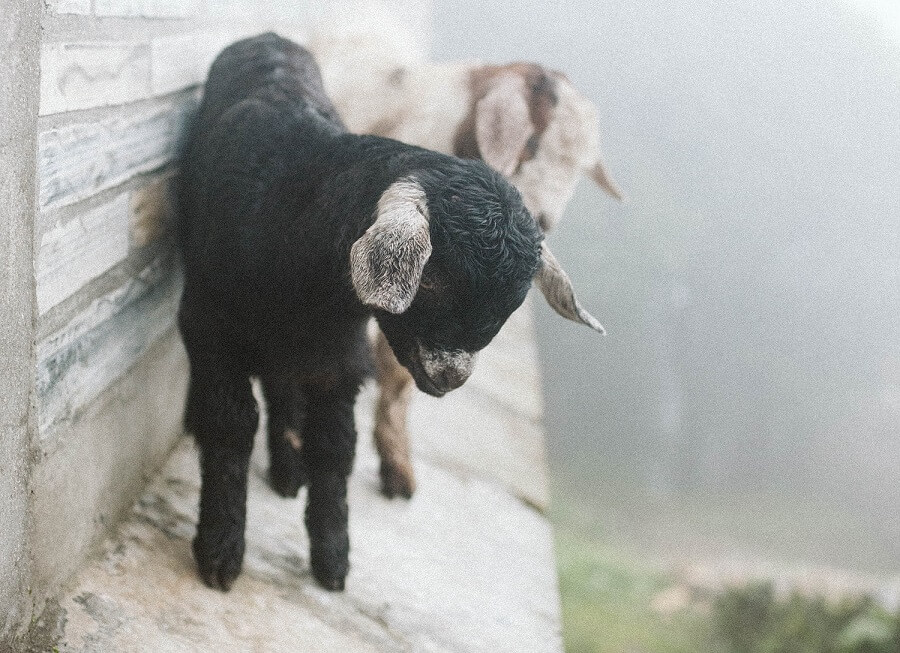
How To Raise Goats For Milk
Milk goats can provide a lot of milk. A single milk doe can give up to 90 quarts of milk 10 -11 months of the year. The milk varies at the end of her cycle and you may taste a difference the last month. The month that a nanny doesn’t give milk is during the last month before she gives birth.
A doe is bred in the fall. She goes into heat for 17-21 days. You will need to breed her to ensure your milk production for the following year. She will give birth 150 days after breeding. Once she gives birth, she will start producing milk.
You will need to milk your nanny goat at least 2 times a day during the duration of her lactation.
There are two methodologies around kid goats and does. Some goat owners like to let the babies nurse from the mother because it is more natural. It bonds the mothers and babies together. This method can dry up the mothers as the babies wean, especially if you don’t catch the babies starting to wean within the first couple of days.
Other owners prefer to milk the goats and then bottle feed the babies. This allows for greater control in making sure that the mamma keeps her milk supply. But, it requires more time in caring for the kids.
My favorite method is to milk the mother daily and then let the babies nurse afterward. This method keeps the nanny’s milk supply up and also allows the babies to nurse the mom.
Raising Billy Goats While Raising Goats For Milk
If you plan to raise goats for milk, then you may think you need to own a billy goat also. It takes breeding to start a does lactation. But, there are several issues to consider if you decide to keep a billy in your herd.
Mainly, billy goats have a very strong goat odor. That is caused by the hormones that they put off. When nanny goats are around billy goats, their own hormones increase. There is speculation that the billy goats’ hormones even out the does into heat.
Most goats are bred in the fall around August and September.
The smell gets into the milk. While goat milk has a mild goat flavor for maximum desirability, a strong goat flavor makes it unpalatable. It is too strong to consume.
As a result, you will need to either keep your billy goats separated from your does or you can rent one instead. Many dairy goat farmers simply rent out a billy goat when breeding season comes.
When raising goats for milk, you will have many kids to deal with. Your goats will breed annually to keep their milk supply (which lasts for about 5 premium years). Goats have an even number of male and female goats. That means you will have to figure out what to do with your males.
Many dairy farmers will sell the bucks or use them for meat. You will need to castrate the males before they are 3 weeks old or their hormones will affect the taste of the meat.
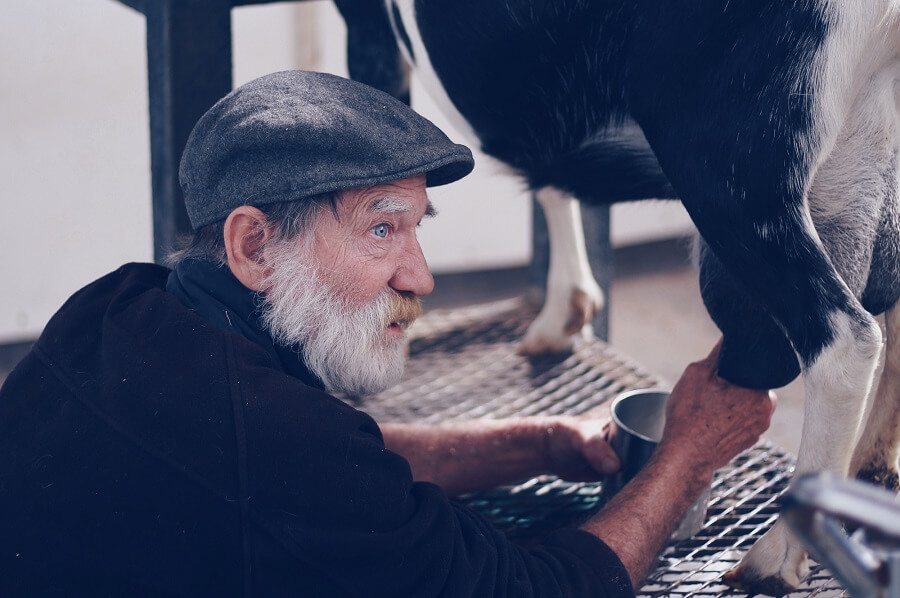
How to Milk a Goat:
Milk a goat twice a day. Keep the milkings to a consistent 12 hours apart. Many farmers will lock the goats head in place so she can’t back up. Feed her a treat during milking. Clean the goats’ underside and tits.
Grip the udder with your thumb and forefinger. Then squeeze underneath to push the milk out. It will probably be helpful for you to practice on a local goat before your goats are ready to be milked.
Best Milk Goat Breeds:
- Nubian: This popular breed is a medium-large goat. They can produce up to 2 gallons of milk but average about 1 gallon each day. They have the highest milk fat content at about 5% fat. These goats are louder than other breeds, but their milk is ideal for soaps and cheeses. They can be milked all year long.
- Alpine: From the French Alps, they are very hardy to cold temperatures. These medium-sized goats average 1 gallon of milk a day. They are originally from France and are durable and steady. They have one of the longest lactation cycles. Their fat content is about 3.5% milkfat.
- Toggenburg: These bearded goats are good breeders. It produces about 3% milkfat. It is often bred with meat goats for dual purpose goats.
- Saanan: This is one of the largest milk goats. It produces a lot of milk, up to 3 gallons of milk each day. Average production is around 1.5 gallons a day. The Saanen milk fat content is about 2.5-3% so it isn’t as creamy as other dairy breeds. This breed is very calm and mild-mannered. These goats get to 200 pounds.
- Nigerian Dwarf: These goats are half the size of average goats. They are great for smaller lots. They produce about 2 pints of milk a day, but they have a high-fat content. Their fat content is 6.1% of the milk. They are wonderful breeders and will have many kids. They are also very mellow and often used as pets. They will even be walked on a leash.
- LaMancha: These funny-looking goats don’t have any ears! But, they are very hardy animals and very friendly. They can produce 1-2 gallons of milk a day. Their fat content is 4.2% of the milk.
- Oberhasli: Originally from Switzerland, these goats are well-suited for colder climates. These goats don’t produce milk year round but will produce about 1 gallon of milk a day. Their milk fat is about 3.5%. They are small and ideal for smaller spaces.
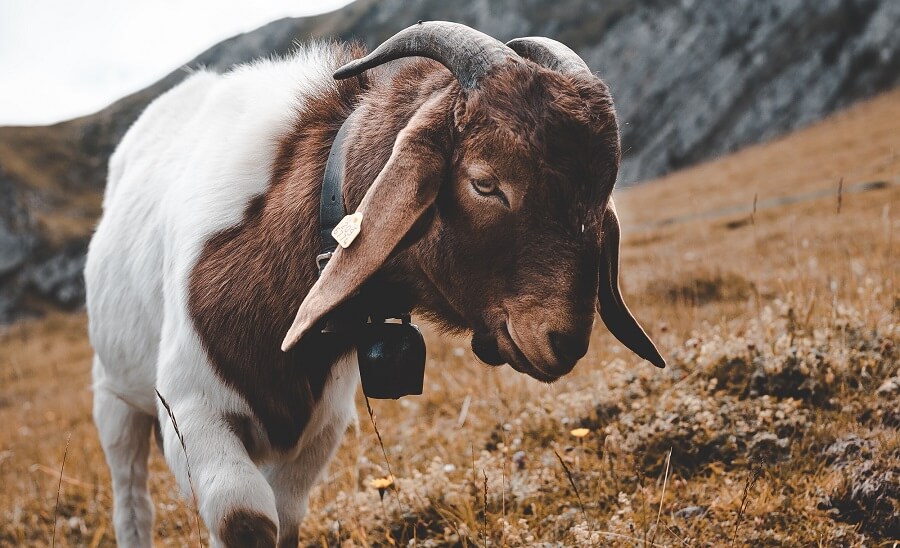
How To Raise Goats For Meat
Specific breeds or crossbreeds of goats are usually used for meat. Often a combination of meat and milk goat works well because milk goats will continue to produce offspring. Goat meat is in demand around the world. Even in the United States, meat is imported in each year to fulfill the demand. There are several breeds that are well-suited for meat goats because they grow quickly and have good flavor.
Best Meat Goat Breeds:
- Boar: Native to South Africa. It has a fast growth rate and is very fertile. It has short horns. Boars come in red, red-white, or brown colors. They are disease resistant and used to hot dry areas. They are ready for slaughter as early as 90 days after birth and will grow to around 200-340 pounds for the bucks and 190-230 pounds for the does.
- Spanish Brough: This goat was imported to the New World by the Spaniards. They have been raised for meat for hundreds of years. They do very well in most climates. They also breed more often than annually. They are also called bush goats, briar goats, wood goats, and scrub goats.
- Kiko: This white goat is very hardy. It thrives in cold climates. It is fast-growing and can reach up to 300 pounds. It has spiral horns. The nannies are good mothers and low maintenance.
- Pygmy: These goats are fertile. They breed every 9-12 months, which allows for more batches of kids. They are often used as pets because they are smaller goats. They grow to between 50-75 pounds.
- Rangeland: The majority of the commercial goat meat comes from rangeland goats. They are generally low maintenance and thrive in dry conditions.
- Kalahari: This goat is from South Africa and does its best in dry hot conditions. The meat is more tender than other varieties. They are reddish-brown and can kid multiple times a year. They are also disease resistant and durable.
- Nubian: Good milk and meat goat. The males reach 175 pounds. They can be bred with boars for even larger offspring.
- Black Bangle: This goat is used for meat primarily in Bangladesh. It is easy to feed and care for. It can have kids multiple times a year and usually has 2-3 kids twice a year. They are ready for reproduction at 15 months old. They are dark with medium-sized horns.
- Verata: These goats are found mostly in Spain. They are durable, healthy goats. They do well in hot and cold climates. They are really good foragers and adapt easily. They are ready for meat at about 45 days. The does also provide a good amount of milk.
Meat goats will need to be castrated young to keep the male hormone from affecting the quality and taste of the meat. Castration is done with rubber bands, which cut off the circulation to their male parts, which fall off in a few weeks. It doesn’t hurt the goats. A castrated male, or wether, can provide 25-40 pounds of meat if it is castrated at about 60 lbs. Many meat goats will grow larger, but the meat becomes tougher.
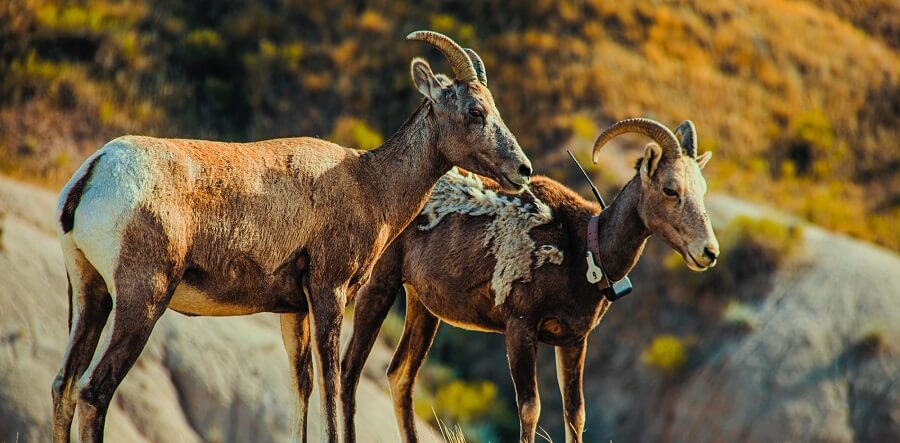
How To Raise Goats As Pets
Many goat breeds do not domesticate well enough to be used as pets. But, there are several breeds that are extremely friendly and mellow animals. These breeds are the best goats for pets because they won’t be as ornery and will be much tamer.
The best goat breeds for pets are:
- Nigerian Dwarf: These goats are small, about half the size of a regular goat. They are friendly, mellow and calm. They love to be petted and will come to their owners.
- Pygmy: These small goats grow to between 50-75 pounds. They breed frequently. They are friendly and calm, which makes them popular for pets.
- Tennessee Fainting Goats: They are also known as myotonic goats. They have a hereditary condition that causes their muscles to contract when startled. This causes fainting. They are very fertile. The male goats get to about 200 pounds. They are considered threatened. They are friendly, easy to handle, and affectionate. This makes them a great pet. (They are also entertaining)
Goats that are used as pets are best domesticated from a young age. They should be handled as newborn kids and even bottle fed. This will help acclimate the goat to its owner and will make it friendlier and tamer.
Pet goats are still not happy as indoor pets but will be a great backyard animal. Even as a pet, goats will be happiest if there are at least two of them.
How To Raise Brush And Weed Goats
Goats are ideal for weed and brush control. They are not as ideal for grass control as goats prefer too many leafy greens. Goats are very well-suited for controlling noxious and invasive weeds. They are used to keep invasive plants out of pastures and wooded areas.
Most bush goats are a mix of dairy and meat goats. They need companionship and should not be set to forage alone. At least two goats should be placed together in an area.
Bush goats are one of the most profitable types of goats to raise. In the United States and other areas, government agencies, businesses, and private individuals are renting goats to control landscaping.
If you choose to raise bush goats, you will want to make sure that you can contain them on your customer’s land. Durable, portable fencing will be needed.
How To Raise Goats In Your Backyard
Goats can be raised in the cities and suburbs. There are several varieties of goats that are especially well-suited for backyards. The best goats for close neighbors are those that are quieter and small enough to be well-suited to a smaller area.
The Best Backyard Goats:
- Nubian Goats
- Oberhasli Goats
- Nigerian Dwarf Goats
These goats can be raised for meat, milk or profit. They are also great as pets!

Related Articles
You might also like these other articles on goats.
What’s More Profitable: Sheep or Goats?
Can Pigs And Goats Live Together?
10 Best Farm Animals For Self-Sufficiency
My Essential Goat Supplies
This list contains affiliate products. Affiliate products do not cost more but helps to support BestFarmAnimals and our goal to provide farm animal owners with accurate and helpful information.
This little giant bucket fits on a fence and this one’s easy to carry.
A sturdy dog collar is essential. Don’t do rope (they’ll break and tangle) or chain (injury!).
A Black Water Tub is way nicer than buckets that tip over. I like to get a 20 or 30-gallon in each pen so my goats have plenty of water, but you can get 100-gallons if you have a lot of sheep in one pen.
Loose minerals in a small bag or a Purina 50 lb bag, and a mineral feeder for free-choice is the best option. One side holds minerals, and the other holds baking soda. Don’t feed sheep goat minerals because it usually contains copper- something that is fatal to sheep.
Hoof trimmers are a necessity because you’ll need to trim your sheep’s hooves every few months. These are nice for the price.
Don’t make the mistake I made by waiting to order a drench gun before you need it. I was surprised by how often I use it. It helps with bloating, dehydration, and other ailments. Here’s a good drench, but you can also drench a bloat solution or water if dehydrated.
Digital Thermometor for when your lambs act sick. You’ll need to know if their temps are too low or too high so you can accurately diagnose the issues.
Vetericyn for wound care. It makes a big difference in a speedy recovery.
Check out this list of goat milk supplies you need if you have milk goats.

